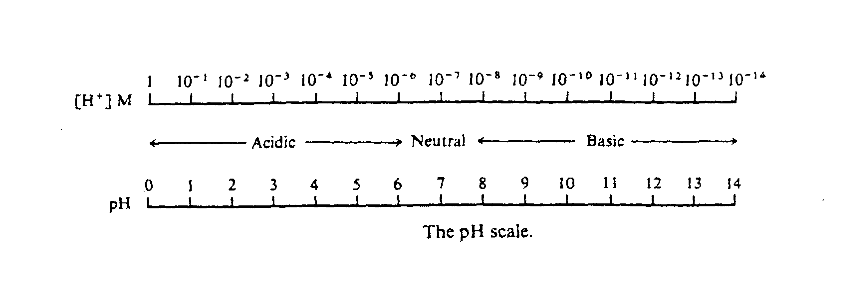PH: Difference between revisions
No edit summary |
No edit summary |
||
| Line 7: | Line 7: | ||
[[Image:PH.png]]<br> | [[Image:PH.png]]<br> | ||
=== Acid Dissociation<br> === | === Acid Dissociation<br> === | ||
Strong [[Acid|acids]] are considered to be completely dissociated into [[Ion|ions]] in dilute solutions. However, weak [[Acid|acids]] (or [[Base|bases]]) are only partially dissociated in solution, and thus an [[Equilibrium|equilibrium]] is established between the [[Ion|ions]] and the undissociated [[Molecules|molecules]].<br> | Strong [[Acid|acids]] are considered to be completely dissociated into [[Ion|ions]] in dilute solutions. However, weak [[Acid|acids]] (or [[Base|bases]]) are only partially dissociated in solution, and thus an [[Equilibrium|equilibrium]] is established between the [[Ion|ions]] and the undissociated [[Molecules|molecules]].<br> | ||
This equilibrium can be represented by the equation: <br> | This equilibrium can be represented by the equation: <br> | ||
[HA]<=>[H<sup>+</sup>]+[A<sup>-</sup>]. <br> | [HA]<=>[H<sup>+</sup>]+[A<sup>-</sup>]. <br> | ||
Where: [HA] is the concentration of undissociated molecules; [H+] is the concentration of hydrogen ions; and [A-] is the concentration of the conjugate base.<br> | Where: [HA] is the concentration of undissociated molecules; [H+] is the concentration of hydrogen ions; and [A-] is the concentration of the conjugate base.<br> | ||
This equation can be rearranged to give a K<sub>a</sub> value, which is a measure of how strong an acid is. | This equation can be rearranged to give a K<sub>a</sub> value, which is a measure of how strong an acid is. | ||
K<sup>a</sup>= [H<sup>+</sup>][A<sup>-</sup>]/[HA] | K<sup>a</sup>= [H<sup>+</sup>][A<sup>-</sup>]/[HA] | ||
Stronger acids will dissociate more and will have a higher K<sub>a</sub> value.<ref>Elliot WH & Elliot DC, 2009, Biochemistry and Molecular Biology; Oxford</ref> | Stronger acids will dissociate more and will have a higher K<sub>a</sub> value.<ref>Elliot WH &amp;amp; Elliot DC, 2009, Biochemistry and Molecular Biology; Oxford</ref> | ||
Revision as of 22:46, 1 December 2011
The negative logarithm of the hydrogen ion concentration, the pH, is expressed as follows:
pH = -log10 [H+]
The pH scale is a measure of hydrogen ion concentration that eliminates dealing with large powers of 10 and compresses a large range of concentrations onto a more convenient scale, between 1 and 14 as show in the figure below:
Acid Dissociation
Strong acids are considered to be completely dissociated into ions in dilute solutions. However, weak acids (or bases) are only partially dissociated in solution, and thus an equilibrium is established between the ions and the undissociated molecules.
This equilibrium can be represented by the equation:
[HA]<=>[H+]+[A-].
Where: [HA] is the concentration of undissociated molecules; [H+] is the concentration of hydrogen ions; and [A-] is the concentration of the conjugate base.
This equation can be rearranged to give a Ka value, which is a measure of how strong an acid is.
Ka= [H+][A-]/[HA]
Stronger acids will dissociate more and will have a higher Ka value.[1]
- ↑ Elliot WH &amp; Elliot DC, 2009, Biochemistry and Molecular Biology; Oxford
